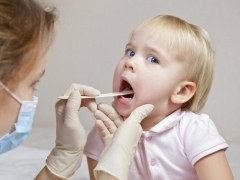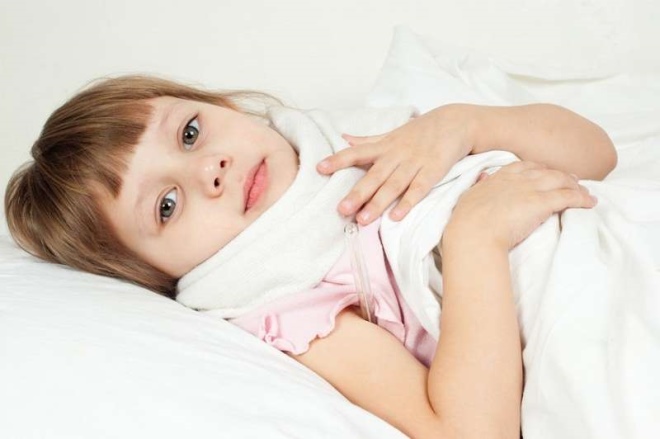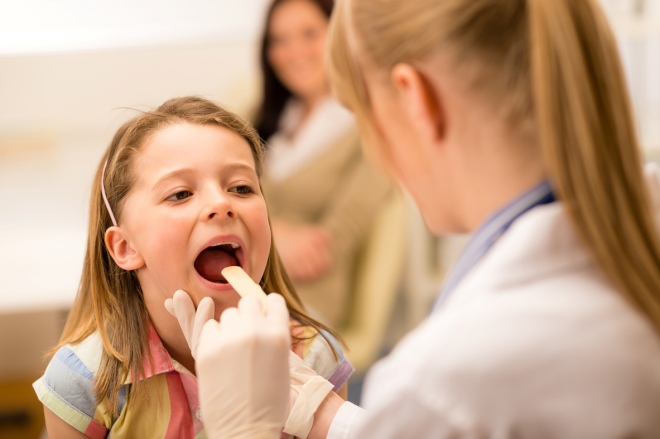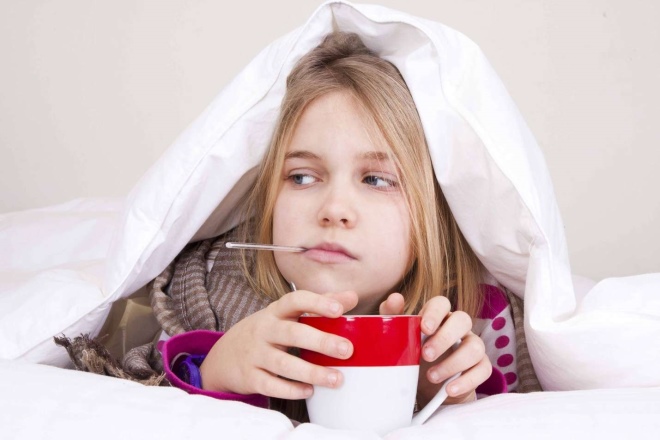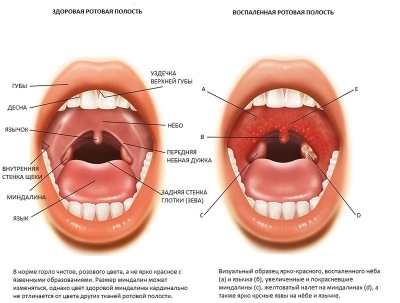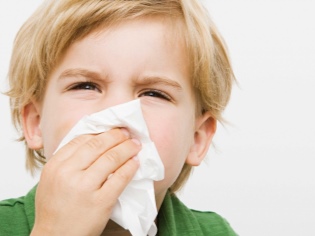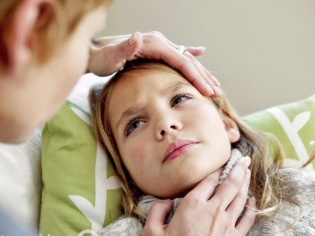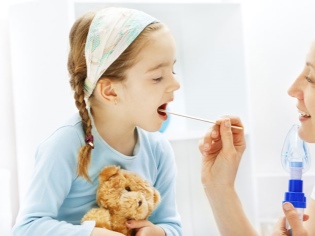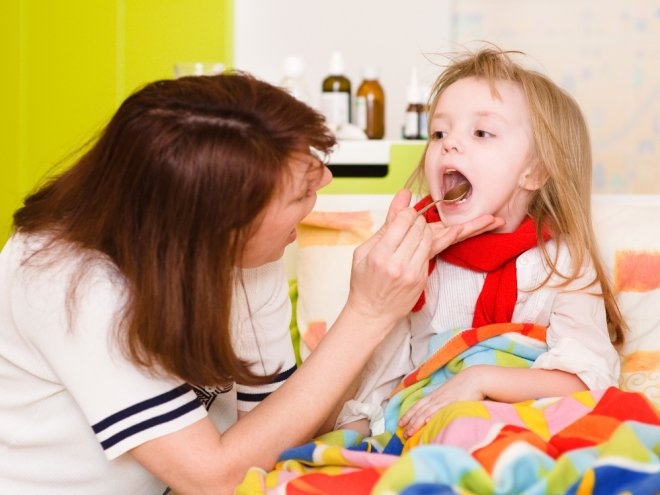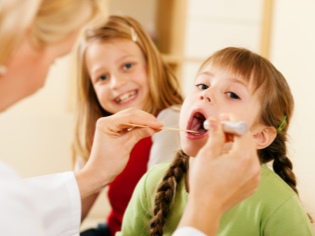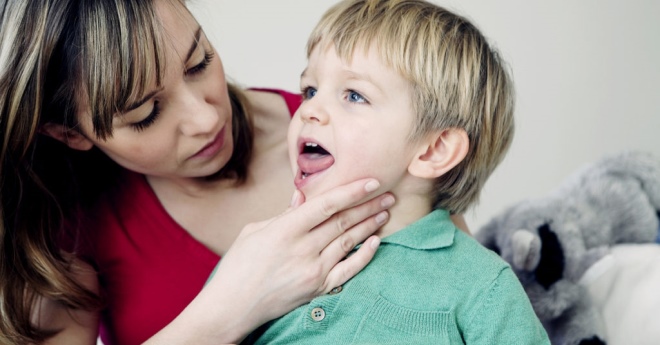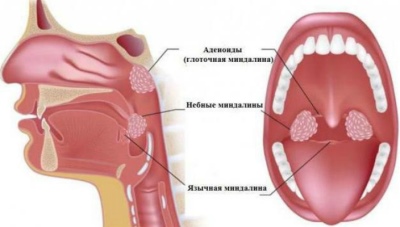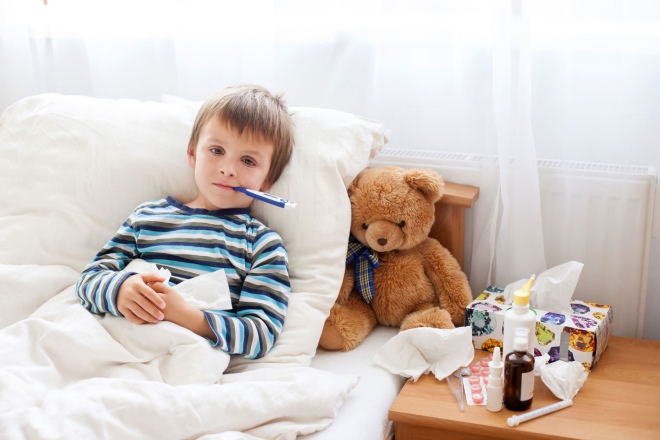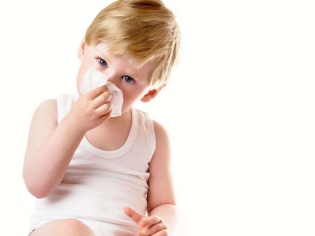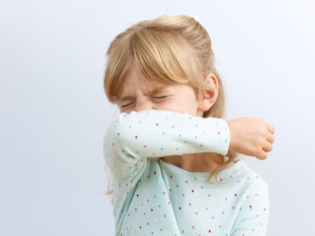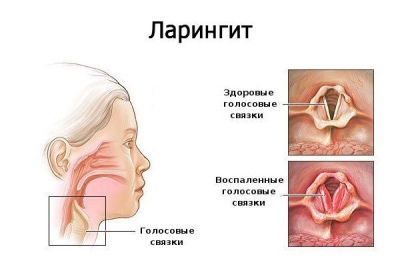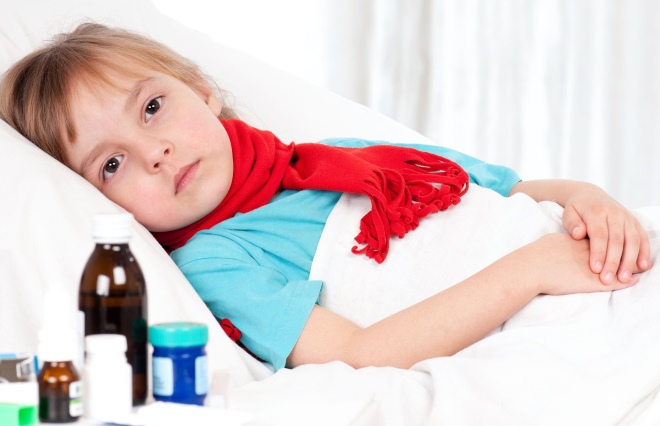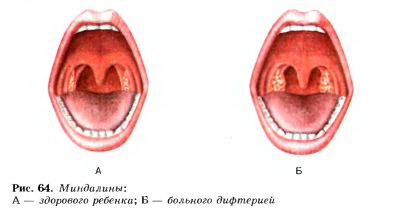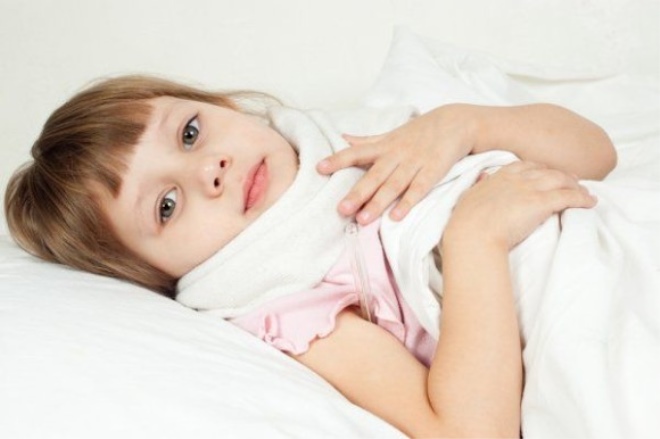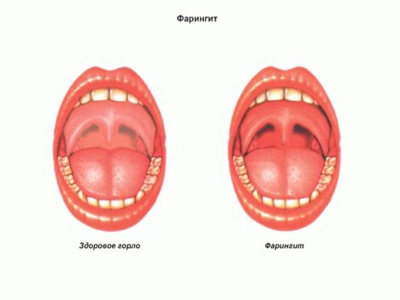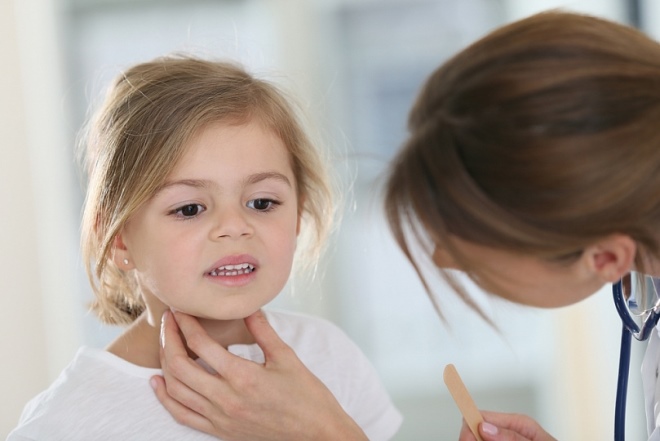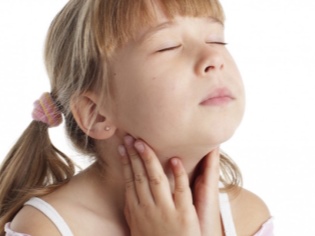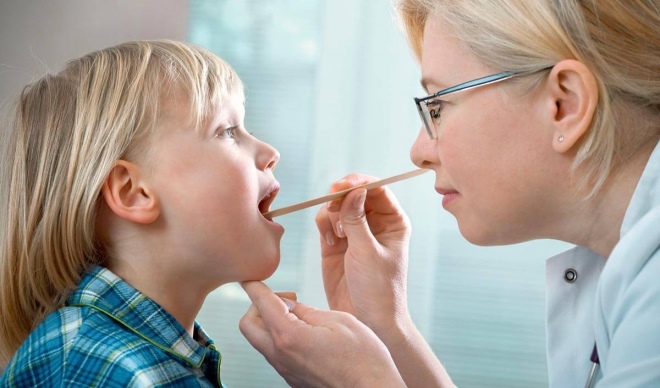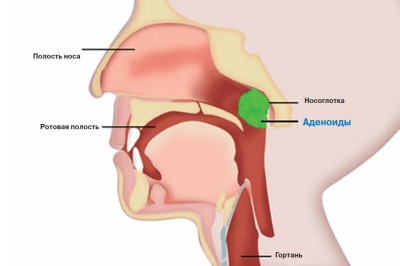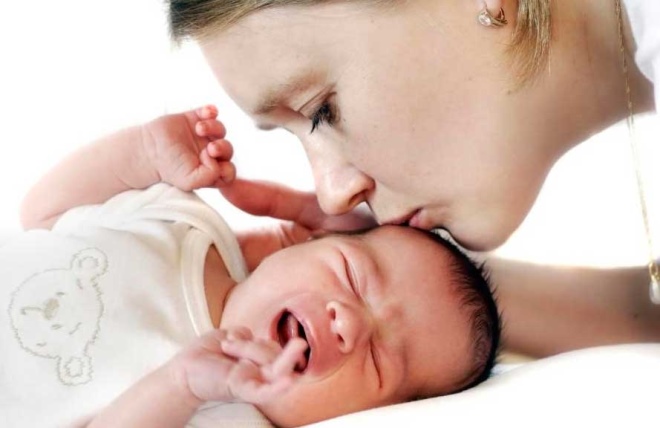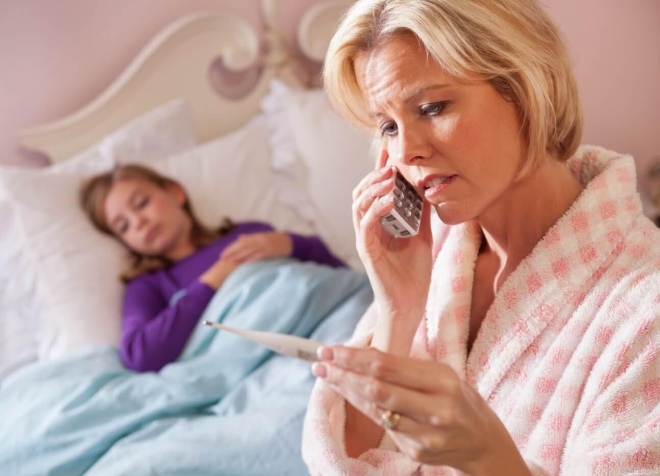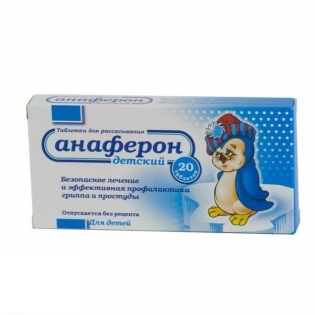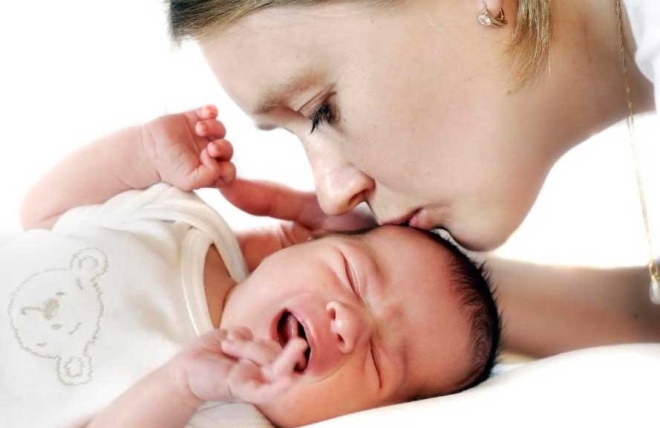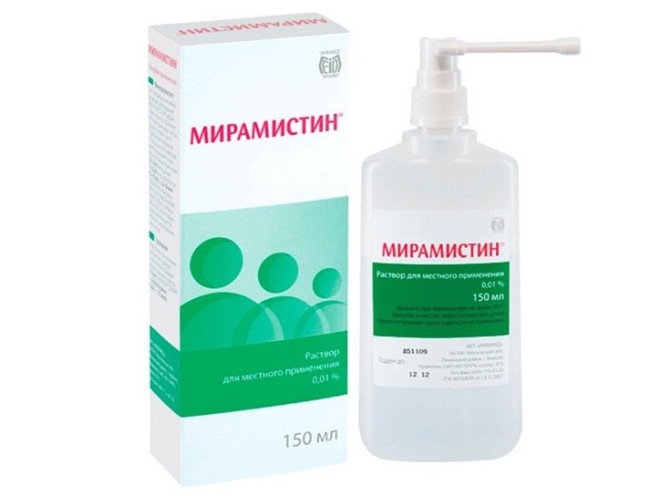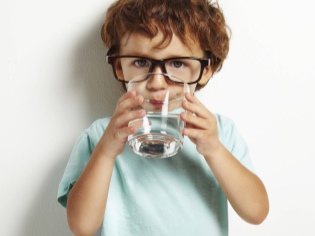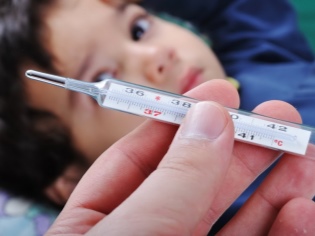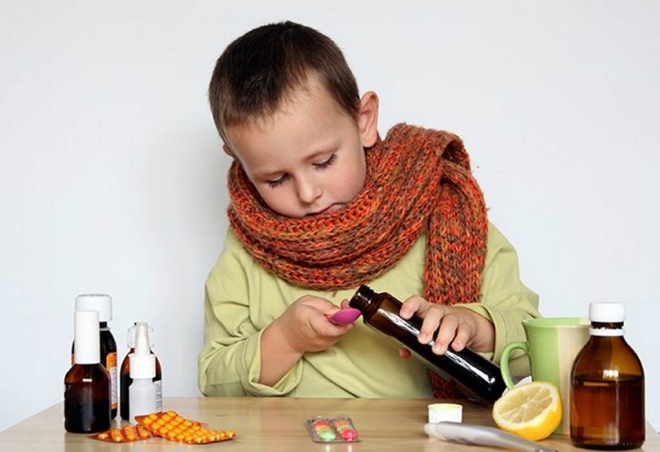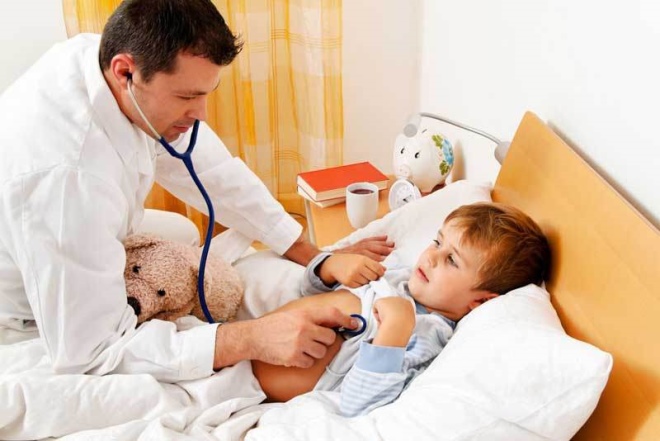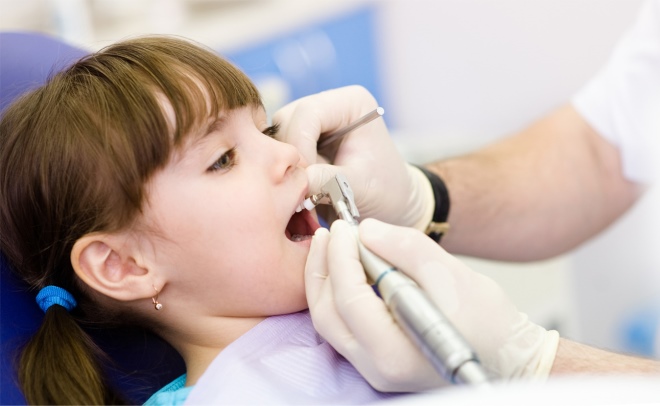What to do if a child has a sore throat and how to treat it?
A sore throat in children can be both an independent symptom and a sign of another disease. It can be quite difficult for parents to figure out why the neck is red. It is even more difficult to understand what to do in this situation and how to treat the baby. Let's try to understand these issues as much as possible.
Why does the throat redden?
The parents of individual babies often complain of red throat, tickling, coughing, pain when swallowing and other unpleasant symptoms, because respiratory diseases are the true leaders in frequency among the child population. There are children who have a sore throat 1-2 times a year, and there are kids who practically do not get out of the doctors, referring to the clinic with relevant complaints up to 10 times a year.
It all depends on the state of immunity of the child. If the natural protection is strong, then the throat will rarely hurt, and if the immunity is weakened, then parents will often have to help the crumb with inflammatory processes in the oropharynx.
In itself, the throat has an important protective function. The immunity of the child is less perfect than the protection of adults. Maternal innate immunity ends about half a year of independent life, and the child finds himself alone with hundreds of viruses, bacteria, fungi, and allergens that can attack him anywhere and anytime.
Most often, children are affected by viruses. Particles of foreign agents through the air into the nose, the mucous membranes of which immediately begin to react to the invasion with abundant secretion of mucus. Parents notice that from the nose flowed. Snot is also an important defense mechanism. But to cope with all the viruses of the nasal mucus is not under force, and the "invaders" penetrate further - first into the nasopharynx, and then into the throat.
A different local immunity begins to work there; the functions of protectors are assigned by nature to the tonsils and adenoids, which consist of lymphoid tissue, like most organs involved in immune processes. The mucous membrane of the larynx also does not stand aside, because the main task is not to miss viruses further into the bronchi and lungs.
In the process of this struggle, the ciliated epithelium, mucous membranes and lymphoid tissue are subjected to a serious attack, an inflammatory process develops in the lesion sites and the throat reddens. Lymphoid tissue swells, increases in size, grows. It hurts the baby to swallow.
There are viruses that enter the larynx through the mouth, with dirty hands, contaminated water, food. Bacteria that affect the throat of a child do not remain idle either, although they cause more inflammation, often with the formation of ulcers, pimples and sores in the throat, high fever. Fungi create a special bloom that you can’t confuse with anything. In case of allergies, swelling and redness are the result of an autoimmune process. However, in all cases, without exception, throat disease is a sign of immunity.
Just to protect the child from viruses and bacteria can not. Even if it were possible, it would be wrong.After all, when confronted with pathogenic microorganisms, immature childhood immunity “learns”, remembers each specific pathogen, produces antibodies to it that protect the baby from the same virus or microbe at the next meeting.
Immunity can be developed as lifelong, as, for example, with chickenpox, and short-term, as with the flu. It is necessary to treat the reddened throat accordingly - as an inevitable and necessary process for the development of the child. However, this does not mean that the baby’s complaints should be ignored. In the overwhelming majority of cases, parents can and should help the crumbs on their own, in other cases, qualified doctors should provide this assistance. We will talk about those and other situations further.
How to examine the throat?
If a child complains that it hurts him to swallow, if he has a cough, fever, run out of nose, the first thing that mom and dad have to do is to examine the neck of the crumbs. In the arsenal of parents there are no special mirrors and spatulas, which are used by otolaryngologists, but an ordinary household flashlight and a flat-handled spoon will help to cope with the task. For young children take a teaspoon, for older children - a dining room.
Correctly carried out inspection should be in a lit room near the window. In daylight, colors and shades of mucous look most reliable. If there is not enough lighting or it is evening outside, then you should definitely use a flashlight.
The child is put straight, the kids are put on their knees, babies are held horizontally. The throat will be seen better if the child opens his mouth and presses the tip of the tongue to the lower lip. Older children can be asked to utter a drawling sound "Y". Not “aaaaa”, namely “Y”. This is important, since at the same time the soft palate is shifted upward as much as possible, opening up a more extensive overview. When pronouncing "A", it opens mostly in the throat, doctors often use this sound when they are examined for signs of laryngitis and pharyngitis. “N” makes it possible to more fully evaluate not only the posterior pharyngeal wall, but also the folds of the vestibule, the amygdala, and the palatine tonsil in the center.
With clean hands, clean the handle of the spoon gently injected into the oral cavity. Pressing the tongue should be in the area of the tip or center, avoiding falling on the area closer to the root of the tongue, because it causes a gag reflex in 100% of cases. There are children with a high level of sensitivity, they even vomit because of the introduction of a spoon and touching the tongue. In such babies, the throat should be examined without the use of spatulas, spoons and other devices.
Assess condition throat need according to the following criteria:
- Color and condition of the inner shell cheeks, tongue, mouth, gums, larynx, lateral parts, central tonsil, called the palatine. In a healthy baby, they are pale pink, solid, without spots and signs of inflammation.
- The size and structure of the tonsils. They should not be swollen, enlarged. The exception is made by children in whom the tonsils are slightly larger than the normal size from birth, and this is the physiological norm for this particular child, a feature of the structure of his throat. Enlarged, inflamed tonsils usually differ in color from healthy mucous membranes, they are more red, sometimes greyish.
- The presence or absence of pustules, growths, ulcers on tonsils and back wall of larynx.
- The presence or absence of plaque on tongue, cheeks, gums, larynx and tonsils. The norm is a small whitish plaque on the tongue in infants, which feed mainly on milk or a mixture. Pathological phenomena include white rich bloom, yellowish and gray patina, as well as membranous plaque, which creates the feeling that the throat is covered with a thin film of a grayish tint.
- It is also necessary to assess the presence and nature bad breath. The most fetid breath becomes with severe bacterial lesions.
First of all, parents should examine the throat of a child in order to understand how urgent and urgent medical aid should be. To interpret the results of the inspection yourself is quite a difficult task. And do not do it.
But the doctor will understand much faster what kind of ailment is involved in this case, if the mother is able to tell him in detail what color, structure the throat was at the time of detection of the infection, whether there were purulent formations, pimples, red spots, plaque, and Additional data - thermometer readings, the presence of cough and its nature (dry or wet), the presence or absence of rhinitis, vomiting, diarrhea, rash, headache, ear pain, etc. It is important for a specialist to know what was at the beginning, as dangerous infectious diseases harak they are terrified by the rapid change of symptoms, when literally in a few hours the clinical picture is altered beyond recognition.
Symptoms as signs of disease
The symptoms of most sore throat diseases are very similar. It is difficult for a child to swallow, and even the liquid with which they are trying to drink it passes with great difficulty. The kid refuses food. Nerve endings with which the throat abounds, are irritated in different ways. In some children, the pain is insignificant, itching, tingling. Others - pain syndrome pronounced, persistent, strong. Redness of the throat may be accompanied by a rise in temperature or leak without it, additional symptoms include respiratory signs - cough and runny nose, headache, sometimes stomach upset and intestines. Sometimes a baby has a rash, and when combined with a red throat, it is almost always a sign of a contagious infectious disease.
Here is a list of the most common diseases among children that are associated with inflammation of the oropharynx. It is not complete, because it is almost impossible to cover all the causes of local immunity.
- Pharyngitis. Have children this disease is more common. Approximately 80% of all complaints of sore throats end with the identification of this particular disease. Inflammation of the pharyngeal mucosa is due to the fact that the baby breathed dry, cold or hot air, inhaled chemicals, as well as viral lesions, less often with fungi and bacteria. Tickling and pain in the throat are characteristic of acute pharyngitis. When it occurs, a dry cough, sometimes the temperature rises to 38.0 degrees.
If the illness is caused by viruses, symptoms of a viral disease are added to these symptoms - a runny nose, uncomfortable pain in muscles and joints, nausea, headache, characteristic rash and others. A visual examination in the throat of the child can see the inflamed pharynx, reddened membranes of the posterior pharyngeal wall, sometimes - small red ulcers on it, a clear vascular mesh.
- Laryngitis. This is the second most common ailment among kids. Its causes are the same as those of pharyngitis (dirty air, hypothermia, viruses, bacteria), but it is not the pharynx that inflames, but the larynx, located just below. The symptoms are very similar - the appearance of fever, pain when swallowing, feeling of tickling, tingling. They are supplemented with a dry, unproductive cough characteristic of this disease, which often has the character of a barking person. The cough gets worse at night. Hoarseness is almost always observed as the vocal cords are compressed due to narrowing of the lumen.
The danger of the disease lies in the fact that inflammation can spread to the trachea, and then the disease is called laryngotracheitis, and when it can occur stenosis of the respiratory tract, which can lead to the development of false croup. Without timely medical care, the child may suffocate.On examination, redness of the larynx, severe swelling of the folds in the area of the vestibule, red spots on the back wall of the larynx, which are associated with increased bleeding of the vessels during edema, are detected. Mild inflammation will be noticeable only in the area of the epiglottis.
- Angina. This is quite a dangerous disease. It can be distinguished from others by the location of the pathological process. In acute tonsillitis, it is the tonsils that are affected. The pharyngeal ring and tonsil are most often reddened. The most common cause of the disease are staphylococcal and streptococcal microbes, and therefore sore throat is considered one of the most contagious childhood diseases. Less commonly, angina occurs due to viruses.
Acute (catarrhal) sore throat occurs with fever with subfebrile thermometer indicators - up to 37.5 degrees, the pain in a small patient is tolerable. By visual examination tonsils are enlargedsometimes covered with a slight grayish tinge. Follicular tonsillitis falls on the baby with high fever - up to 39.0 degrees, and this, in fact, is the first sign of illness. Sore throat intense, echoes her child may feel in the ear. The nearby lymph nodes may increase. The tonsils are friable, in some children they are covered with white or yellowish spots.
With lacunar sore throat, the son’s state of health is even more severe - high fever, intoxication, nausea and diarrhea. A visual examination of the tonsils shows a white or yellow fragmentary patina that looks like specks.
Necrotic angina develops at a temperature of up to 40.0 degrees with the formation of areas that have become dead after pus on the tonsils and at the mouth of the gaps. Viral herpetic sore throat, which is most often caused by herpes virus Coxsackie, is always very acute, the temperature is high, there can be vomiting and diarrhea. When viewed during a herpes infection on the tonsils and around them, reddish blisters are seen, similar to acne or bumps.
- Pharyngomycosis. This is a pharyngitis caused by a fungus. Previously, doctors rarely diagnosed such a disease, but recently there has been a steady trend towards an increase in the number of facts in children. Fungal inflammation of the throat is severe, the degree of danger of the disease exceeds many inflammations, because fungi can cause sepsis and damage to internal organs. The temperature in case of pharyngomycosis is 37.0-37.5 degrees, sore throat, sore throat, sometimes the child begins to cough easily.
On examination, a white or yellow patina is detected that can cover the tongue, the back wall of the larynx, the tonsils, the arch. Very often, unfortunately, this disease after the acute stage becomes chronic and then worsens in children up to 8-10 times a year.
- Allergy. If there are antigen substances to which the baby’s body gives a specific reaction, the throat may turn red and swollen for this reason. The most dangerous is angioedema, it can even cause choking. Most often in an allergic reaction, throat pains are long, almost chronic.
Allergic laryngitis and allergic tracheitis are most commonly recorded in childhood. When viewed from a child, the swelling of mucous membranes is fixed, they have a pale grayish color. The baby complains of pain when making swallowing movements, it can be difficult to breathe, while inhaling, wheezing is sometimes heard. An allergic throat with allergies rarely causes fever.
- Mechanical injury, thermal damage. These include burns of the larynx and pharynx, oral cavity, and hypothermia. To injure the neck, a baby may inadvertently swallow a toy item, for example. On examination, there will be a pronounced redness of the mucous membranes mainly at the site of injury or mechanical impact.
- Infectious diseases. The throat, as a direct participant in immune processes, necessarily reacts to acute infectious diseases. So, redness and swelling, as well as the appearance of a rash in the throat are possible with infectious mononucleosis, measles, chicken pox, diphtheria and scarlet fever. With each of these diseases, the nature of changes in the larynx and pharynx, as well as on the tonsils, will be different.
With scarlet fever, the tongue and pharynx become bright crimson and become covered with pronounced pimples, while diphtheria in the throat purulent plugs can be fixed. With chickenpox, the throat hurts slightly, and there are no significant visual problems other than redness. The throat is not a source of information for the diagnosis of these ailments, since each of the diseases has its own characteristic picture.
- Adenoids. Throat inflammation in adenitis occurs most often due to drying out of the mucous membranes, because the child breathes primarily through the mouth, nasal breathing is completely or mostly impaired. However, it is not possible to consider changes in these tonsils, since they are located in such a way that only an ENT doctor can use a special mirror to look into them.
How to understand that a baby has a sore throat?
It is most difficult to guess the pain in the throat of a baby, because the child cannot complain or describe his feelings. Parents can be suspicious of the changed behavior of the crumbs. He begins to act up, sleep badly and restlessly. The little one asks for food, but as soon as they give him a nipple or a breast, he throws it and starts to cry. This is due to the fact that it hurts him to swallow. Pain can cause a complete rejection of food.
The temperature may rise, and may remain within the normal range, a runny nose is also not a mandatory sign. Quite often, with the inflammatory process in the throat, the baby produces more saliva. However, drooling is also a rather dubious symptom, because it is also characteristic of other conditions, such as teething. The mucous membranes of the throat of an infant are especially vulnerable, they are loose, are better supplied with blood, and therefore the inflammation in children up to one year old is much more painful and stronger.
An objective method for the diagnosis of diseases of the throat in the crumbs of the first year of life is a visual examination, which is better to entrust the doctor. If necessary, the doctor will take smears from the larynx to examine them in the laboratory to identify the true causative agent of the disease. This will help to appoint a more accurate and competent treatment, because viral ailments are not treated at all as caused by bacteria, and the treatment of fungal diseases is not similar to therapy for an allergic reaction.
First aid
If the child has a sore throat, if he has osyp and wheezes, complains about the inability to swallow and breathe normally, parents are obliged to call the doctor as soon as possible or to take the child to the clinic. The first option is preferable, because the infection, which is manifested by such a symptom, can be very contagious, and the rest of the children who sit in line at the doctor’s office do not deserve the dubious honor of being infected.
While the doctor is going to call, it usually takes half a day, or even more. During this time, parents are obliged to provide first-aid baby in anticipation of a qualified inspection. The measures they can take are fairly simple:
- If there is a temperature, the child should always be put to bed and provide him with peace. You don't have to sleep, you can watch cartoons quietly, read a book. The main thing - do not run and do not jump. It is important not to shout, not to speak loudly. It is best to generally limit speaking, whispering, and any stress on the speech apparatus.
- If the baby refuses to eat, do not insist. The gift of persuasion and other measures of pedagogical influence will be useful in another - the baby must be plentifully watered.Drink should be given warm, avoid sweet, sour, carbonated drinks. The closer the temperature of the liquid to the temperature of the body of the child, the faster the liquid will be absorbed in the body. If the baby refuses to drink from a cup or bottle, you should give a drink from a spoon.
- If the child asks to eat, food should be given after processing it with a blender. All food should be puree. Food should not be given smoked meat, pickles, pickled products, milk, canned food, spices.
- If the heat is high, you need to give "Paracetamol", if the pain is unbearably strong - syrup "Erespal». This effective remedy has not only anti-inflammatory action, but also antihistamine, as well as moderately anesthetizes. Of the medicines, this is all that can be used for first aid; the doctor will prescribe everything else if necessary.
Treatment
Treatment of a sore throat is rarely symptomatic, usually it is a whole set of measures aimed primarily at the therapy of the underlying disease. Since we know that most often red and granular throats are a sign of viral damage, parents may have an overwhelming desire to purchase more antiviral drugs for their home kit. This is not necessary for several reasons.
Firstly, there are no antiviral drugs that would act on a wide range of viruses. Each virus has its own antivirus. What virus has hit at the moment, even the doctor will not answer until he has completed all laboratory tests. Secondly, the effectiveness of most antiviral drugs has not been clinically proven. This means that such syrups and pills will not have any impact on the process of recovery of the child.
There may well be indignant parents who gave their children "Anaferon" and "Oscillococcinum"And we are confident that the drugs helped them a lot. It was not the pills that helped, but the child’s own immunity. Manufacturers of antiviral drugs indicate that the course of treatment is from 3 to 7 days. During the same time and without pills in general, the body quite successfully copes with a viral infection.
In fairness, we note that drugs with proven action also exist. But there are few of them, on the shelves of pharmacies there are practically no such cases, because they are mainly used in hospitals for health reasons and most often intravenously. Therefore, miracle pills and drops, widely advertised and known to each parent, have no relation to such effective and truly “working” drugs.
Therefore, the treatment of a sore throat in case of a viral illness should be based on the creation of conditions optimal for recovery. Only with them the immunity will be able to quickly cope with the task, and the symptoms of the disease will recede. Here are the conditions:
- The child must breathe fresh and cool, sufficiently moistened with clean air.. Indoors it is best to turn on not a heater, but a humidifier. Recommended values for humidity, which pediatricians are advised to adhere to, are 50-70%.
- Baby should be given drink a lot.
- Saline can moisten the nasal passagesto prevent nasal mucus from drying out. Older children should additionally be given saline to rinse their throats. With severe sore throat, you can use "Viniline", Lubricating them affected areas, and irrigation antiseptic, such as"Miramistin».
- It is strictly not recommended to splash into the inflamed throat alcohol based sprays, gargle with solutions containing alcohol, and irrigate the throat with lugol solution, since iodine can cause a strong overdose, and all that it contains alcohol dries out the mucous membranes. Local immunity works effectively only when the shells remain sufficiently moist.
- Temperature in case of viral disease, it is necessary to shoot down only if it is very high, stable, and the baby is small.It is best to think about the antipyretic only after the thermometer has passed the mark of 38.5 degrees. In other cases, the temperature helps the immune system to produce antibodies and interferon protein.
- Bacterial and fungal infections of the throat are not always cured quickly at home. These diseases are more severe, and if the child is under 3 years old, it is very likely that parents will be offered treatment in a hospital under the supervision of doctors around the clock. In some cases, but not always, antibiotics and antifungal drugs may be required.
- The doctor usually prescribes antibiotics after an analysis of throat baccosis is prepared.when it becomes known which microbe caused the inflammation. Most often, children begin treatment with penicillin antibiotics. In most cases, you can do without painful injections, and the therapeutic effect will be quite satisfactory from antibiotics in pills or syrups.
- Sometimes it is enough spray with antibiotics for topical use. ("Angina", "Isofra"- nasal drug, which is used for the throat). Fungal lesions of the throat are always treated only in combination, combining the use of local remedies to the throat and the ingestion of anti-fungal drugs.
- If you are allergic to a child, antihistamines are prescribed., hormonal therapy, local antiseptics in the throat. The main treatment in this situation is to limit contact with the source of protein-antigen, to which the body gives an inadequate response. To help find out what exactly your baby is allergic to, an allergist will help you, who may conduct a special study of allergy tests.
- In all cases, the child is usually allowed to use lozenges and absorbable pills., but this is done not to cure something, but to temporarily numb the affected parts of the throat. Self-treatment such candies can not be considered.
How to treat can not:
If the sore throat is treated improperly, the child’s condition can be significantly worsened, the disease will become chronic or serious complications will occur, mainly in the respiratory system. Responsible mom should remember a list of actions that should not be done if the child complains of pain in the throat:
- You can not give antibiotics for viral damage. This does not help recovery, but increases the likelihood of complications several times.
- Do not apply warming compresses to the throat.especially on the basis of fats and alcohol. Intensive warming contributes to the spread of the inflammatory process, especially when it comes to bacterial infections.
- In no case should you try to remove it yourself., scrape, remove purulent deposit, plugs, polyps from the tonsils or the back of the pharynx. This can lead to bleeding and secondary infection.
- Do not inhale without a doctor's permission.. Steam inhalation is contraindicated at high temperature, bacterial and fungal infections, with viral - they are ineffective. Inhalations using a nebulizer with the use of drugs are usually indicated for pulmonary and bronchial diseases, since small particles of medicaments penetrate deep into the lower respiratory tract. For the throat, again, there is little effect, and therefore the procedure is not considered appropriate.
- You can not soar legs, do vodka rubbing and wrap your baby with cold water at high temperature.
Treatment of folk remedies
Basically, folk sore throat recipes are based on gargles. If you follow all safety rules (avoid alcoholic solutions, iodine, hot liquids), then such procedures will not cause harm. True, rinsing has practically no effect on the healing process.
It is harmless to gargle with broths of healing herbs if the child is not allergic to them.Such plants include chamomile, sage, plantain, calendula. Do not hold honey rinses for children who are not 3 years old and allergic children. It is better to refrain from rubbing badger fat, because it greatly violates thermoregulation, which is dangerous at elevated temperatures.
When is a doctor urgent and necessary?
An emergency ambulance should be called for urgently in cases when the throat is sore and has festered in a child under one year old. At high temperatures (38.5-39.0), an ambulance is necessary for all children under 3 years of age, since they have a high risk of developing seizures and the onset of dehydration. If the child is wheezing, breathing is very difficult, and the larynx is much swollen, so that the neck swelling is visually determined, “Ambulance” should be called immediately, as this condition threatens to suffocate. For sore throat with high fever and purulent formations, a doctor is also required as soon as possible.
Prevention
In order for the throat to hurt as rarely as possible, parents should take care to strengthen their immunity from a very young age. In the room where the peanut lives, it should not be hot, it is necessary to maintain a certain level of humidity, to air and clean more often with products that do not contain chlorine.
Hardening, cool baths, douche can be done even to infants, naturally, following all the rules for conducting such procedures and taking into account the individual characteristics of the child’s development. You can temper the throat separately, thereby increasing local immunity. It is not necessary to feed the child only warm, he should be able to drink and cold drinks. The most delicious remedy for the prevention of frequent diseases of the throat - ice cream. All kids agree to accept it, and without long preliminary persuasions.
A child aged 2-3 years should teach gargle. It is useful not only during treatment, but also for prevention. It is not necessary to use therapeutic solutions, it will be quite enough if the crumb every day after eating will gargle with the most usual boiled water cooled to room temperature.
During the cold season, when an increase in the incidence of acute respiratory viral infections is recorded around, one should refrain from visiting, along with a child of public gathering places, especially in enclosed areas. Most viruses spread from person to person by airborne droplets. Do not encourage sucking fingers, the constant presence of hands in the mouth, so dangerous pathogenic bacteria can get into the throat. It is not necessary to feed the child from natural sources with boiled water, and also give him poorly washed vegetables and fruits.
Once a year you should definitely visit the dentist and make the child sanitization of the oral cavity, because many bacteria that multiply in the mouth during caries can cause severe damage to the mucous membranes of the throat.
For more information about sore throat in a child can see in the next video.
